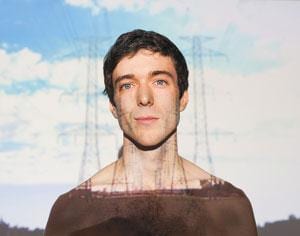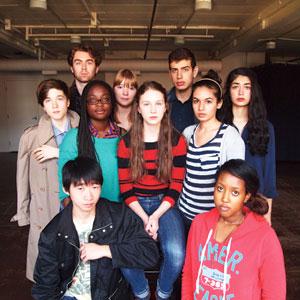
Tannahill is a graduate of Ryerson's film school. Credit: N Maxwell Lander
The next time you’re driving back into the city, take a second look at the discarded and disused spaces around its edges. Those empty buildings, fields and parking lots are more alive than you’d think. Not just a haven for skyrocketing weeds and ingenious raccoons, they serve as an escape for suburban teenagers.
“These places become sites for communion and coming of age,” says writer/director Jordan Tannahill. “The suburbs are specifically designed to counter all forms of subversion, so those who act subversively have to create their own spaces. Parents often see these environments as somehow corrupting. But particularly for queer teens, they often become community meeting points and spaces of refuge.”
The Ryerson film school graduate’s current theatre project, Concord Floral, imagines the goings-on at one such space. Named for a Vaughan-region greenhouse that sat vacant for 15 years, the Twin Peaks–style tale follows a group of teens fleeing societal conventions and pressures.
The second in Tannahill’s suburban coming-of-age trilogy, Edge City (part one was 2010’s SummerWorks hit Post Eden), Concord melds Italian writer Giovanni Boccaccio’s 14th-century allegorical novella The Decameron (a tale of 10 teenagers fleeing plague-ridden Florence for a country villa) and Toronto artist Kris Knight’s dreamy paintings of suburban youth.
“I love Kris’s work, and I was originally thinking of the show as a live embodiment of it,” Tannahill says. “The Boccaccio text fit so well with his imagery it made sense to incorporate both references. Both have this idea of teenagers escaping society and creating their own world.”
Like Boccaccio’s teens, the kids of Concord Floral also flee their town. But they aren’t running from a plague. Rather, they succumb to a mysterious skin ailment one by one. Believing it might be some kind of curse connected to the disappearance of a girl after a debaucherous field party, they flock to the ramshackle nursery hoping distance from society will keep them safe.
“There’s also a Kill Bill–esque revenge fantasy,” Tannahill says. “One of the girls believes her friend was raped and goes about hunting down the guys who did it. It’s inferred in the text that she was the missing girl’s girlfriend, but it’s never made totally clear.”
Though sexuality is foregrounded, in keeping with teenaged reality, much is left bubbling just below the surface. Relationships are ambiguous, touches are furtive. Sex is talked about more than it happens.
“Often with teenagers, you have a lot of grey area between friendship and romance,” Tannahill says. “Particularly for queer teens, if there’s an attraction to someone who identifies as straight, figuring out the boundaries can be confusing. Just because you have sex with someone doesn’t mean they’re going to be willing to admit it happened or let you redefine the relationship as anything more than friends.”
Rather than hire adult actors to play teenagers, Tannahill thought he’d get more mileage working with actual teens. Ranging in age from 13 to 19, his cast members are acutely aware of the realities facing youth today. Though working with non-professionals is a leap of faith for any director, in this case it is essential to the process. Not because he couldn’t find older actors who could convincingly play younger characters, but due to the danger of romanticizing the teenaged experience.
“The story of youth fleeing society has been told many times before, but usually in a fetishizing or idealizing way,” he says. “It’s important to me to have a certain kind of truth in the creative process, and adults can see their own teenaged years through this nostalgic lens that just isn’t realistic.
“There’s a sense of self-loathing and fear that comes with getting older, and that leads to a desire to rewrite one’s personal history,” he adds. “Most of us don’t realize our context until we’re out of it, and the teenage experience is so often dictated by adult fantasies of that experience. I grew up watching movies about teenagers made by adults, and they never matched my experience.”
Though he doesn’t let it be the defining element, Tannahill’s own experience growing up in an Ottawa suburb percolates throughout the piece. He had been aware he was gay for several years when he finally opted to come out the first week of Grade 9. “It was something that was always implied, so I decided to just be open about,” he says. “It was a bit of a preemptive strike against bullying, and I wore it like an armour.”
Despite foregrounding his identity, it didn’t make dating any easier.
“I had dalliances, but I never actually dated anyone in high school or had an official relationship,” he says. “My sexual experiences were always furtive blowjobs in basements illuminated by the Lord of the Rings DVD menu. There was this sense of getting sex done quickly and quietly because the partner was always a straight-identified friend. I think that really informed my views on sexuality, and I had this idea that queer love was perpetually unrequited. It wasn’t until I got older I realized healthy, reciprocal relationships were possible.”
Many of the work’s more personal elements come in the form of projected film, which Tannahill often incorporates in his shows. Returning to the neighbourhood of his youth, he set about exploring and documenting his own spaces of teenaged sanctuary, like the parking lot behind Giant Tiger, the Zellers hill and the Dairy Queen where everyone bought their drugs.
“Concerned parents and community members often consider these places problematic, and there’s always a hue and cry about noise, destruction or drug remnants being found,” he says.
“But that’s largely a manifestation of the fear of losing one’s children as they grow up. Every adult has the experience of being young once, and they know how important it is to have space from the grown-up world to develop and become your own person. In my case, these spaces weren’t just a place to hang out and drink or do drugs. They were hugely formative in how I understand being queer.”


 Why you can trust Xtra
Why you can trust Xtra


